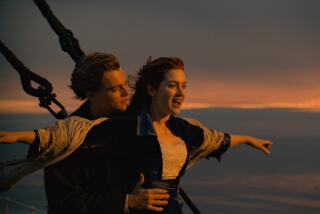Sunken Ships Become TV Stars
- Share via
CHICAGO — Live, from the bottom of Lake Ontario, it’s . . . Jason and the sunken 19th-Century schooners.
It’s not MTV or even a cartoon, but this “Jason” show has had tens of thousands of select schoolchildren glued to the tube for more than a week and their teachers don’t seem to mind a bit.
In a fascinating marriage of archeology, history and high-tech razzmatazz, elementary and junior high school students gather daily at 14 different locations around Canada and the United States to take part in a live, two-way satellite television hookup with an underwater exploration team both above and deep beneath Lake Ontario.
With the aid of “Jason Jr.,” a cousin of the state-of-the-art deep-sea probe that found the sunken remains of the Titanic in 1985, youngsters watch as the well-preserved hulks of two warships that capsized in a storm during the War of 1812 are archeologically mapped.
The ships--the Hamilton and the Scourge--have been lying undisturbed under 300 feet of water for more than 176 years. The location of the Navy vessels, the children are told, will remain a mystery for fear of vandalism. What they do know is that the live broadcast comes from a barge about six miles off St. Catherines, Ontario.
Their host is marine geologist Robert Ballard, who designed the concept to inspire interest in the kinds of technical disciplines that all too many of today’s American youngsters seem to disdain.
“Most kids have closed the door to science by the 10th grade,” said Ballard from his vessel/stage. “We’re just trying to keep the door open.”
One day last week, youngsters sat captivated as the screens filled with computer generated three-dimensional images of the wrecks. Then they shared in the excitement of Ballard and his crew as everyone--both those on the ship and the students in the museums--got a simultaneous first glimpse of a fully intact cannon.
Another big moment came when 10-year-old Lacolis Robertson in Memphis maneuvered Jason via a remote control joy stick. “I liked it when he drove Jason,” said Tyler Thomas, 10, later as he walked out of the auditorium with the rest of his class.
The idea to involve kids in the archeological mapping project came to Ballard after he received “tens of thousands” of letters about the Titanic from children. Ballard and the JASON Foundation for Education, a partnership between industry, research facilities, museums and educational organizations, decided to exploit the wrecks to get students excited about science and technology.
“Math is like wind sprints,” said Ballard, a former UC Santa Barbara basketball player. “You’ve got to sell them on the game and they’ll do the wind sprints. They’ll do the mental push-ups.”
The program began April 30 and will run through Saturday . In Chicago alone, more than 14,000 youngsters from schools in Illinois, Indiana, Wisconsin, Michigan and as far away as Missouri will travel to the city’s Museum of Science and Industry to take part. Thousands more from Boston and Dallas to Victoria, British Columbia (but none in California), are also linked by satellite to Ballard’s barge. They can see the wrecks up close, listen to Ballard explain what’s going on and ask questions of him and other experts.
Before attending these 90-minute sessions with Ballard, the youngsters work with an extensive curriculum--prepared by the National Science Teachers Foundation--that includes building milk carton boats only to drown them in a windstorm. They also bake hardtack, an unleavened bread once a staple of a sailor’s rations. Through the hands-on activities, they gain knowledge of math and the various sciences and history required for an archeological exploration such as this one.
“When you read something, you remember 10%. When you hear something, you remember 15%. But when you do something, you remember 80%,” said Ballard. “And that’s the key to learning, get them out of the classroom and get their hands on.”
This is the second year Ballard has invited children to partake in his adventures. Last year through “telepresence,” as he calls it, thousands of students visited the Mediterranean Sea to explore the Star Hercules, the deepest known ancient shipwreck.
Next year, if funds hold out, he plans to take the show to the Galapagos Islands in the Pacific Ocean off South America. But getting supporters in additional cities as excited as the kids has not been easy. Ballard is working on getting next year’s program directly into St. Louis schoolrooms but he says he can’t find a place for it in Los Angeles. “We have tried so hard,” but the minimal $2.50 cost per child shut all doors,” said Ballard.
The excited students described the experience as “neat” and “cool” as one of the presentations ended. But, they also left seeing how pollution and turbidity make the live underwater shots murky. And, because Ballard repeatedly stresses the importance of geometry, physics and biology, they seemed less certain that these classes are boring and useless.
“I like oceans and science,” said Chad Osmer, 9, who came with his fourth-grade class and plans to return to the museum with his mother. He wants to see more of what Ballard does. Although he’s still not sure what physics is, he is not deterred. Osmer has added the morning’s activities to his list of possible careers, which he says is composed of “this and baseball.”
More to Read
The complete guide to home viewing
Get Screen Gab for everything about the TV shows and streaming movies everyone’s talking about.
You may occasionally receive promotional content from the Los Angeles Times.






